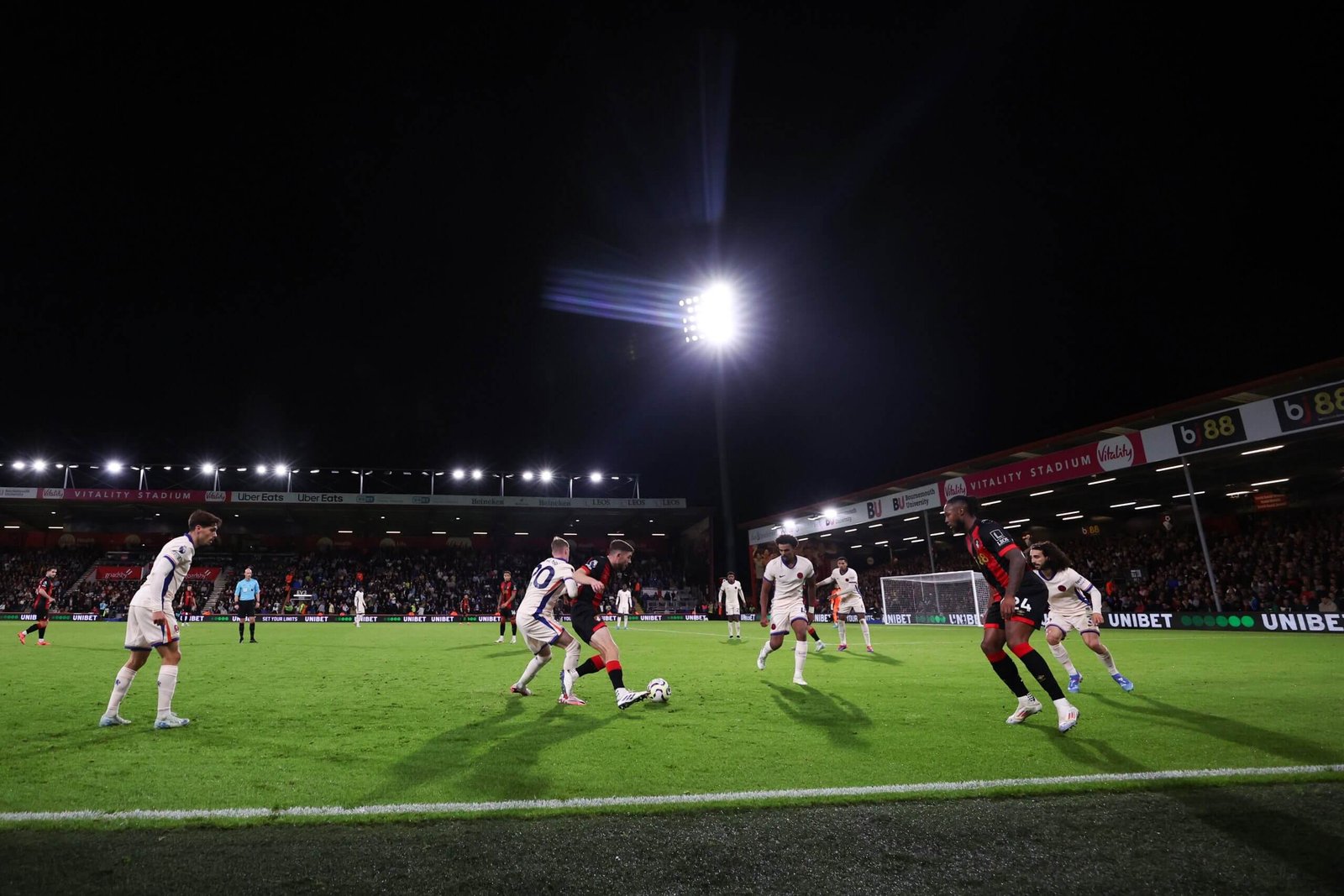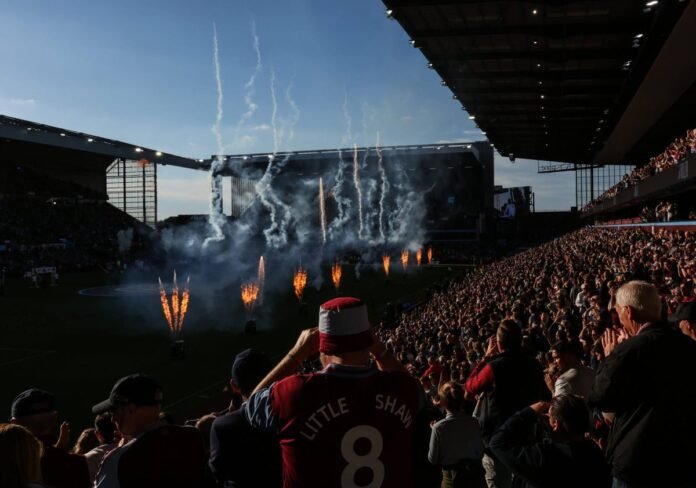Aston Villa will welcome Champions League football to Villa Park for the first time on Wednesday when they host Bayern Munich.
After 41 years away, the mood ought to be one of celebration. This is a fitting first home fixture back in Europe’s premier club competition — it is a mouth-watering re-run of the 1982 European Cup final, in the tournament’s previous iteration, which Villa won 1-0. The Class of ’82 are sure to be revisited, not least with the game coming so soon after the death of Gary Shaw, one of that team’s stellar talents.
But the club’s return to this level will be tinged with anger and disappointment, too, given the price hikes for fans in attendance.
Villa revealed ticket prices for their group fixtures would start at £70 ($94) for adults, rising as high as £97. The lowest-priced ticket for those without season tickets will set them back £85. Around 27,000 of the 42,640 capacity at Villa Park is made up of season ticket holders.
The club refused a request from their fan advisory board (FAB) to cap prices at £70 and came under criticism from supporters who pointed to the lower prices for the Premier League’s other clubs involved in the competition. Liverpool and Manchester City’s most costly tickets are priced lower than the cheapest at Villa, who have also increased general admission matchday tickets by an average of 12 per cent.
The Villa Supporters Trust called the ticket structure “extremely disappointing” and urged a rethink, without success.
Villa’s president of business operations Chris Heck defended the pricing. “Achieving our sporting ambitions while complying with financial stability regulations requires difficult decisions,” he said.
“Financial fair play rules prohibit owners from covering shortfalls to finance this ambition, so we need to generate as much revenue as possible through sponsorships, merchandise and ticket sales to ensure that we can keep the club where it rightfully belongs — competing (and winning) at the top of English and European football.”
Aston Villa and Wolverhampton Wanderers fans pay tribute to the late Gary Shaw (Nick Potts/PA Images via Getty Images)
As clubs increasingly seek to diversify their revenue streams, the proportion of their income made up by matchday ticketing is changing. But despite record income from TV deals, prices are still on the rise.
Of the 20 Premier League clubs this season, 19 upped the price of a season ticket to watch their men’s team, with Crystal Palace the outlier.
Season ticket holders, who purchase an annual pass that guarantees them a seat for all 19 of their club’s home league matches, pay less per game than supporters who buy individual match tickets. The prices for individual games also change depending on the opposition, with games split into different categories.
Ticket prices for English clubs in the Champions League 2024-25
| Team | Adult home ticket price range (£) |
|---|---|
|
74.30 – 106.80* |
|
|
70 – 97 |
|
|
30 – 61 |
|
|
37.50 – 62.50 |
Clubs have faced a backlash after raising the price of tickets both directly and by stealth with the reduction or alteration of eligibility for concession bands, while tickets for individual matches have risen at several clubs.
Protests were held by fans of several Premier League clubs, including Tottenham Hotspur, Manchester City and Fulham. At Chelsea, there were price rises of five per cent on general admission matchday tickets, with the club citing inflationary pressures as justification after 13 years of price freezes. Their season ticket prices rose by eight per cent.
Brentford’s season ticket prices rose by 10 per cent, newly promoted Ipswich’s by eight per cent and Nottingham Forest’s by around 24 per cent — although changes to the banding and eligibility make this higher in some cases. Wolverhampton Wanderers supporters faced rises of between 17 and 23 per cent for adults, with some under-21 prices rising by as much as 46.6 per cent.
At Southampton, again restored to the Premier League, there has been a hike of 15 per cent.
— WHUST (@whust_whufc) September 25, 2024
West Ham United supporters petitioned their club over a decision to limit the availability of concession tickets and maintained their protests at their Carabao Cup tie at Liverpool last week, while Tottenham fans railed against the decision to raise season ticket prices by six per cent, which will generate an extra £2.5million to £3m per year.
That figure pales into comparison with income from broadcasting rights.
Typically the revenue from gate receipts includes the takings from matchday hospitality, although this is not specified in clubs’ accounts.
“Matchday income is still a core revenue function,” Dr Dan Plumley, senior lecturer in sport finance at Sheffield Hallam University, tells The Athletic.
“But what we’ve seen at the top end of the Premier League and the elite is that it’s probably less important to them in their revenue mix picture because it’s a bit more balanced.
“You’ve only got broadcasting and then commercials to throw into the mix of the main three. The biggest clubs in the Premier League are less reliant on matchday income and their commercial income is probably now outstripping broadcasting.
“But if you were to drop down a little bit and into the lower tier of the Premier League, you’ll find that broadcasting money makes up probably 60 to 70 per cent of some clubs’ income.
“If you’re looking at how you can generate a little bit more revenue then moving the age brackets around, offering fewer concessions and making more people fall into what we might term a ‘general bracket’ — which is normally the highest priced tickets, depending on where you sit in the stadium — is one way of doing that.”
Bournemouth have the lowest proportion of matchday income at £5.4million compared to overall revenue of £141m, equating to just 3.8 per cent. At Brentford, the figures are 6.8 per cent of a £166.5m revenue, while Villa took £18.7m on matchdays from a £217.7m revenue — 8.6 per cent.
At the other end of the scale, and ignoring Ipswich (more on their 36.7 per cent figure later), Arsenal have the highest proportion of the established Premier League clubs at 22.1 per cent where £102.6million income represented 22.1 per cent of their £464.6m total. Tottenham’s 21.4 per cent — £117.6m from £549.6m — was close behind.
For Arsenal, that was an increase from £79.4m a year earlier. The notes in their accounts reference the return of European football to the Emirates as a contributory factor, with four Champions League matches staged at home.
Although this only meant one further home fixture than the previous season (they had played three Carabao Cup matches in 2021-22), the prestige of the Champions League meant higher prices were charged and therefore greater revenue received. Arsenal noted that it was the first time matchday revenue has returned to more than £100m since the 2014-15 season.
a
It shows how matchday revenue is affected by not only the number of home fixtures played in a season depending on successful cup runs, but also the type of fixture and potentially the level and glamour of the opposition. Inevitably the more in demand a match is, the more clubs will charge for tickets.
Returning to Ipswich Town’s position at the top of the table above, their 36.7 per cent is an outlier because they received significantly less from broadcasting rights due to their participation in League One in 2022-23, the season to which their latest set of accounts refer. That does, though, demonstrate the greater importance of gate receipts the lower down the pyramid you go.

Luke Woolfenden and Kyle Edwards celebrate Ipswich’s promotion from League One in April 2023 (Joe Giddens/PA Images via Getty Images)
Deloitte analysis revealed that, across the Premier League, revenue increased 14 per cent to £867million in 2022-23. Broadcast revenue primarily drove that rise but, with a record average league attendance of 40,291, there was a 14 per cent increase in matchday income.
That is a result of clubs increasing prices, rising attendances and more matches for clubs who progressed deeper into European competitions. Manchester City won the Champions League that season, while West Ham won the Europa Conference League.
“We will unfortunately (see clubs continue to increase prices),” says Plumley. “That won’t appease the traditional match-going fan. What we’ve seen is that they’ll not do it in drastic steps. They do it in a way where it will slightly tip up.
“There’s examples that are kind of out of the ordinary. Villa is a good example of squeezing a little bit because of the Champions League, because of the amount of time they’ve had out of that main European competition.
“They know that people are going to want to be part of it and, therefore, they’ll feel they can justify those prices.
“The other side of that equation is always, ‘Where does it stop?’. As long as there are bums on seats, if somebody isn’t prepared to pay the ticket price but somebody else is, then clubs will think, ‘We’re still filling the ground and you’re still paying the prices’. It will be a collective look at the fanbase, not on an individual level.
“It’s very easy to add several million over eight games, especially if you’re targeting corporate hospitality.
“This upsets fans because Villa will take around £50m from the prize pot and the TV contract and the English Premier League position in the European football market. So people ask, ‘What’s an extra few million?’. But the other side of that equation is that money possibly funds someone’s wages for the year, or investment in the infrastructure. ‘We can use that money to do X, Y and Z’.”

Bournemouth’s Vitality stadium is the smallest ground in the Premier League (Catherine Ivill – AMA/Getty Images)
The other factor which limits clubs’ ability to generate income on match days is their stadium size.
Bournemouth (£5.4m) and Brentford (£11.3m) have the lowest matchday incomes of any sides in the Premier League during this accounting period. The Vitality Stadium and Gtech Community Stadium hold 11,307 and 17,250 spectators. The latter, completed in 2020, has more capacity for higher end seating which makes up a chunk of the matchday income at clubs.
That is becoming ever more important as clubs try to squeeze money out of fans in every way they can.
Watching football has become about more than just the 90 minutes of the game. Clubs are trying to encourage fans to spend more in the stadium rather than outside while offering more premium experiences, such as tunnel clubs. Football is becoming an event.
“The only way you can put the revenue line up is by either charging a little bit more for the tickets, expanding the stadium or building a new one. The latter two are really costly,” says Plumley.
“It is a business-focused industry and pushing up the revenue line is really important to clubs. They’ll find a way to do this as much and as often as they can. Yes, they’ve got to be careful, but the reality is that we’ll see more of those tactics (increasing ticket prices directly and by stealth). There’s a fear of missing out.”
While it may be dwarfed in comparison to broadcast income, matchday tickets will continue to play a relatively small, but significant, part in Premier League clubs’ ability to generate income. That is likely to spell bad news for match-going supporters.
(Top photo: Marc Atkins/Getty Images)
Read the full article here


